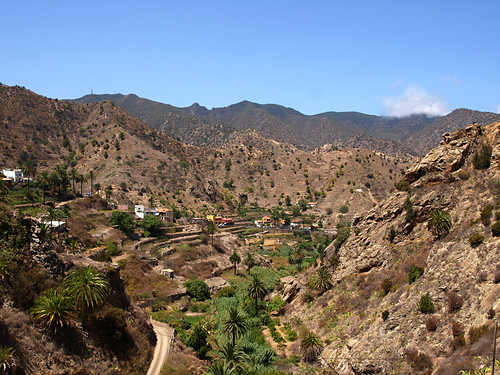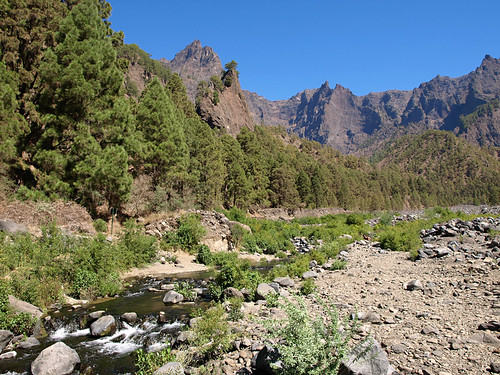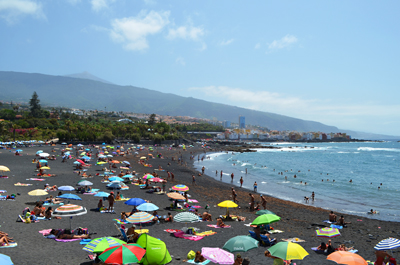Which is the best Canary Island for hiking? That’s easy, everyone knows the answer to that question, even people who come out in a rash at the very idea of walking in the countryside.
It’s La Gomera. Or is it?
Having walked across all of the Canary Islands we’ve learned that it’s not quite as simple as that. All of the Canary Islands offer good to fantastic walking in very different terrains.
But the fact is some are better than others.
This is our views on each of the islands.
Tenerife

For years overlooked by the British (not other nationalities) as a serious walking destination thanks to its one dimensional image as a fun in the sun, cheap and cheerful holiday destination. With pine forests, laurisilva forests, wide valleys, narrow ravines, coastal paths and a volcanic wonderland with the world’s third highest volcano as a centrepiece, Tenerife offers more diverse walking than many people realise. An ancient network of paths link historic settlements creating ready made walking trails all over the island.
Plus Points: The most diverse landscapes of all the islands. Most people come to sunbathe leaving many trails free of other walkers (apart from a couple of the ones that are popular with the big walking groups).
Minus Points: Parts of Tenerife are built up, so being able to step from your hotel and onto the trail is rare. The best walks require quite a bit of travelling to get to.
Gran Canaria

Another island that is overlooked in terms of what it has to offer walkers, yet there are plenty of stunning walks all across Gran Canaria. We’ve walked from south to north and were blown away by the scenery and the diversity of the walking which, because there is no Mount Teide in the way, has much more sweeping vistas than Tenerife. Hill towns are generally more picturesque than on Tenerife and routes traverse arid plains, flat plateaus, pine forests, steep ravines and rocky coastlines.
Plus Points: Beautiful and quiet routes for the same reason as Tenerife. There are also more places where there are a choice of routes directly from rural hotels.
Minus Points: Quite a few routes aren’t very well signposted but apart from that, there are few minus points.
La Gomera

The most famous Canary Island for walking and it is spectacular. A small local population and a shortage of decent beaches means that most of the island has escaped development, leaving nature to run wild. Dense ancient laurel forests and rainforest carpet much of the centre and north giving some parts the appearance of South America or Central Africa whilst some southern slopes are dead ringers for the Atlas Mountains. Ravine after ravine means that walking on La Gomera usually involves lots of ascents and descents on any one route.
Plus Points: Fabulous routes. You can walk from pretty much anywhere to anywhere; the island is geared up for walkers and signposting is better than other Canary Island.
Minus Points: You’re often in a rainforest so it doesn’t take a genius to work out what that means. But the biggest minus is that La Gomera is a victim of its fame. You won’t be alone on many of the routes.
La Palma

We’re extremely fond of La Palma. It’s big enough to be lively when you want it and small enough for tranquility when that’s desired. Yet it is ignored by mass tourism making it possibly the purest of the Canary Islands. There’s a reason it is known as La Isla Bonita – it is the fairest of all. La Palma has some of the most stunning walking routes you’ll find on any island. La Caldera de Taburiente is one of the best routes we’ve walked and Marcos y Cordero one of the most unusual. With forest, rivers, waterfalls and newly formed volcanic lands, La Palma is an island full of surprises.
Plus Points: The walking is simply stunning and the island is lush, beautiful and very Canarians.
Minus Points: It can be really convoluted to get to the best walks and although tourism is low key, these ‘best’ walks can be relatively busy.
Lanzarote
There are people who love lush forests and then there are those who prefer arid lands pockmarked by volcanic cones and lava fields. Lanzarote will suit the latter. The landscape is interesting, different and dramatic from a geological perspective and vistas across to La Graciosa are magical.
Plus Points: Not very challenging walking through violent landscapes and walking on La Graciosa is like walking on a desert island.
Minus Points: There’s very little diversity.
Fuerteventura

You’d expect Fuerteventura to be similar to Lanzarote, it’s not. Where Lanzarote’s landscape is aggressive and masculine, Fuerteventura is softer and more feminine. It’s also vibrant; rolling hills of burnt orange that change colour. Fuerteventura hides its secrets in ravines, caves and dry riverbeds where streams trickle, goats watch you curiously and vultures soar. There’s more diversity than you’d imagine.
Plus Points: Totally ignored as a walking destination there are some fabulous hikes through pretty towns and over those incredibly orange hills. This feels more African than any of the other islands.
Minus Points: Absolutely no shade combined with an ever present wind can become tiresome. Route signs are almost non-existent apart from the GR131 route.
El Hierro

El Hierro way out at the end of the world is an enchanting place for walking. It feels unlike any other Canary Island and it wouldn’t take too much to believe in magic on an island like this. Despite being small, there are wonderfully diverse routes through atmospheric forests, across sweeping valleys and through farmlands that could easily be the Yorkshire Dales. El Hierro still feels undiscovered. The little walking cherry on the Canary Islands walking cake.
Plus Points: Full of wild and wonderful walking and surprises like the spooky and surreal sabine forest. Routes are decently signposted.
Minus Points: It’s small so not as much diversity as some of the bigger islands.
So which is the best Canary Island for walking? Like I said at the start, it’s not that simple.
La Gomera is tops for getting straight onto the trail; Tenerife has by far the most diversity… and Teide National park; La Palma boasts the biggest wows and El Hierro the most magic whilst Gran Canaria has a little bit of each.
The truth is, it’s impossible to choose.
Jack is co-owner, writer and photographer for BuzzTrips and the Real Tenerife series of travel websites as well as a contributor to online travel sites and travel magazines. Follow Jack on Google+





This was in response to a comment that the poster subsequently wanted removed, so it looks as thought it’s here for no reason now. However, I’m leaving my reply as it might be useful for other people.
AEMet is the most reliable and is the official Spanish Met Office. But you won’t get accurate forecasts that far ahead. However, the weather in Tenerife tends to follow very similar patterns throughout the year. September is still summer but not quite so hot as August, so a great month for walking. There is little or no rain (you would have to be really unlucky) north or south. The start of October is much the same. The season changes towards the end of October/ beginning of November when there can be quite serious rainfall (sometimes only short and sharp like a monsoon) but you shouldn’t need to worry about rain at all.
Great analysis. How difficult would it be to hike on one island, and then travel to another island to hike the next day? Is it cheap/quick/easy to get between the islands?
Thanks. Depending on the islands it wouldn’t be too difficult. For example, you could walk on Tenerife then catch a ferry to La Gomera, which only takes around 45 mins, and hike there. Travel isn’t that cheap but getting between the islands is relatively easy. There are inter island flights as well as ferries and these can cut down the travel time.
hay,
do you think travelling alone is safe?
and is there an island that attracts more solo hikers than others?
thanks
Hi Nataly,
The Canary Islands are a very safe and friendly destination. I’m not aware of an island which attracts more solo hikers than others, we pass many solo hikers of both sexes on routes. But there are islands which attract more hikers. La Gomera is the obvious one but La Palma, Tenerife, Gran Canaria and El Hierro all have wonderfula routes. Lanzarote and Fuerteventura also have good routes but not as diverse scenery. Best for diversity is Tenerife, Gran Canaria and La Palma. But if you like your islands small then La Gomera or El Hierro may suit more. As a general rule of thumb, areas with a Canarian population as opposed to purpose built resorts are safer as there’s a strong sense of community and family.
Hi Jack
We have the last week of October to spend in the Canary Islands and it looks like Gran Canaria has won the contest. Would you recommend to stay in one place and hire a car to drive to different hikes each day? Or is it better to stay in different places near walking trails? Considering we have 7 days, which hiking routes would you recommend?
Thanks!
We helped put together a walking holiday on Gran Canaria for a specialist slow travel holiday company in Britain which involved walking across the island. Here’s a link to an article we wrote about it which should give you an idea of where to stay. I’d definitely recommend staying in a couple of places where there are lots of hiking options.
Hi Jack,
Thanks for your article. I’m looking to hike on one of the islands (probably Tenerife, Gran Canaria or La Palma) in December. I would prefer to be able to carry what I need and stay along the way and I would like to either do the GR131 or if I choose La Palma the GR130.
The one thing I am concerned about is accommodation. I would prefer not to carry tent, sleeping bag etc so would prefer B and B, hostels etc.
Do you know if its feasible to hike for a day and be able to arrive in a village and find somewhere to stay? I can’t find much information available online in the form of a reliable guidebook or other information on accommodation.
Sorry for the late reply Joe, we’ve been travelling a lot of late and I missed this completely. The only islands where you might struggle with a plan like that are Lanzarote and Fuerteventura where there aren’t big local populations in rural areas. On the other islands there is plenty of rural accommodation but not always easy to find online. Gran Canaria, Tenerife and La Gomera are best for choice of rural hotels and there are usually pensions and rooms available in towns. But it’s worth searching for ‘alojamiento’ combined with the name of the place you think you might want to spend the night just to make sure. We include accommodation suggestions in our Walk this Way Tenerife guidebook, but we tend to steer clear of the GR131 and GR130 so not much use I’m afraid.
Hello, my husband, my toddler daughter and I are thinking of travelling to the Canary Islands in January. We love hiking but I’m worried that the weather won’t be suitable for it at that time of year, what do you think?
We’re hoping to go for 10 days and split our time between two islands, perhaps Tenerife & La Palma; does that sound feasible?
Thank you!
The winter months are the main walking season on Tenerife and other Canary Islands Sima, so your plan is entirely feasible. The weather is good all year round and a climate which is warm in winter make for much more enjoyable walking conditions than in summer when it can be too hot. Saying that, it gets cooler the higher you go so layers are essential. There can be short periods of bad weather so it’s also important to check what conditions are like before setting off on a hike.
Hi Jack
We are planning spending 2 to 3 weeks in the Canaries over Xmas 2017. We are keen hikers but not climbers. We would like to find perhaps a 8 to 10 day hike, or two hikes of 4 or 5 days where we can hike between accommodation. We would not carry camping gear so need to find accommodation and options for all evening meals. If you could suggest which island would suit our plans and would be good in December that would be great thanks. Also any suggested reading to plan our routes and beds etc.. best wishes
Tim
We help put together these sort of holidays in the Canary Islands for UK Slow Travel specialists Inntravel and in our opinion Gran Canaria is the best for what you’ve got planned. La Gomera would come second. All the islands (the western ones especially) are god for hiking and offer different experiences, but those two are best for walking door to door from small rural hotels. December is a good month to do it whichever island.
Thanks! Very useful information for trip planning.
Hi great information. We like to travel without a car and just do day hikes there and back). Are the Canaries Ok for this type of holiday or do you need a car? Which base would you recommend? Looking at going next May for 2 weeks.
Hi,
There are some islands which are better than others for hiking without using a car. And there are some areas on individual islands which are better. There are a number of factors you have to take into account, including what walking options are available from accommodation or what public bus services are like. On all the islands the bus service exists mainly for the local population and as a result the best hiking areas where there are low levels of residents have the most infrequent services. But there are loads of options. We often don’t have a car when we walk on some of the Canary Islands so it is possible. But there are so many options it would take far too long to got through them. The best idea is to start with which island/s you intend to visit and take it from there.
Thanks for the write up. If you could only do one, 3-4 day hike on the Canary’s which one would you choose?
Hi there,
Trying to decide between a 3-4 day hike in Gran Canaria or La Palma. Any recommendations?
Thanks